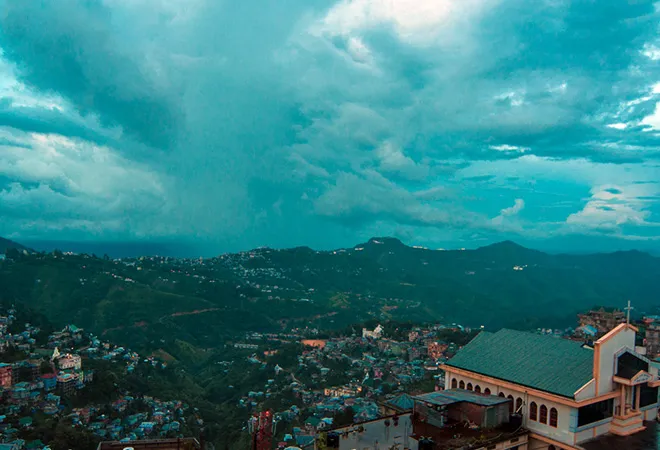
In the beginning of May, External Affairs Minister Sushma Swaraj held an unusual meeting with the chief ministers of the northeastern region. The meeting on 4 May was convened to discuss ways to boost ties with the ASEAN (Association of Southeast Asian Nation) countries in consultation with the northeastern States. This move emphasised importance of States in India’s foreign policy decision making. The meeting is a recognition that northeastern region lies at the centre of India’s ASEAN relations.
The meeting, chaired by the External Affairs Minister, was attended by Sarbananda Sonowal, the Chief Minister of Assam, N. Biren Singh, the Chief Minister of Manipur, Conard Sangma, the Chief Minister of Meghalaya, Neiphiu Rio, the Chief Minister of Nagaland, Biplab Kumar Deb, the Chief Minister of Tripura and Chowna Mein, the Deputy Chief Minister of Arunachal Pradesh. The chief ministers of Sikkim and Mizoram, Pawan Kumar Chamling and Lal Thanhawla respectively, could not attend the meeting.
The meeting discussed at length the issue of connectivity within the region and across the border, with the aim of enhancing development in the region. Swaraj emphasised that the governments of the northeastern region were active stakeholders in the Act East policy, a major policy initiative of the Narendra Modi government to connect with the Southeast Asian countries.
The northeast region comprises eight States — Sikkim, Assam, Arunachal Pradesh, Meghalaya, Manipur, Nagaland and Tripura. The region, considered remote and landlocked, shares 80 percent of its border with other countries, including China, Nepal, Bhutan, Bangladesh and Myanmar. The region is connected with the rest of India through a narrow corridor at Siliguri in West Bengal, popularly referred to as the Chicken’s Neck. The region is lagging behind in the development from the rest of the country. And remoteness is considered a major reason for the under-development.
Northeast India, considered remote and landlocked, shares 80 percent of its border with other countries, including China, Nepal, Bhutan, Bangladesh and Myanmar.
Northeast has the uniqueness of being the only region having overland links with the ASEAN nations. Besides, it also enjoys close historical and cultural linkages which will help in strengthening ties with Southeast Asia. Considering its proximity to the ASEAN region, some observers of the Indian foreign policy have been advocating opening the region to Southeast Asia to foster development. The present thrust by the central government to integrate development in the Northeast by enhancing its relationship with the ASEAN is a potent initiative. The MEA press release issued following the meeting stressed on this aspect. It said greater connectivity and economic integration of India’s Northeast with its eastern neighbours was considered a key focus area for growth and development of the region.
The government of India, under sub-regional cooperation initiatives like BIMSTEC (Bay of Bengal Initiative for Multi-Sectoral Technical and Economic Cooperation) and BBIN (Bangladesh, Bhutan, India, and Nepal) has initiated various projects to improve the connectivity of the Northeast with the eastern neighbours. Of late, a realisation emerged among the policy catalysts about the need for internal preparedness, especially for the northeast region to reap the optimal advantages of these initiatives. The reason for such understanding is, largely, due to the long-running insurgency in the region, which disturbed peace and development; complex socio-ethnic dynamics that resist the influx of outsiders in the region, a natural outcome of the connectivity, difficult climatic condition and geographical terrains, etc. Considering the complexities and ground realities, the development in Northeast will require special handling.
The government of India, under sub-regional cooperation initiatives like BIMSTEC (Bay of Bengal Initiative for Multi-Sectoral Technical and Economic Cooperation) and BBIN (Bangladesh, Bhutan, India, and Nepal) has initiated various projects to improve the connectivity of the Northeast with the eastern neighbours.
In this context, the meeting was encouraging as it gave opportunity to the States to voice their views on the foreign policy matters concerning them. The expectation is that the meeting will contribute in ascertaining the priorities in the context of policies with the ASEAN region.
Some of the suggestions made by the Chief Ministers demand special mentions. There was a suggestion to simplify visa procedure to encourage tourism and people to people connectivity. In this respect, it was suggested that there should be arrangements for providing visa on arrival facilities in all the capitals of the region, particularly for visitors from the ASEAN region.
Another important suggestion was for the opening of direct air services between Guwahati and Southeast Asian countries. There was also a demand for the completion of the Trilateral Asian Highway and reopening of the Stillwell Road connecting Kunming in China.
Encouraging investments from the neighbouring countries was also discussed. The Tripura Chief Minister suggested that Bangladesh should be encouraged to invest in Tripura. With Tripura, Bangladesh enjoys a trade surplus. He said that the total trade volume between Tripura and Bangladesh was Rs 304.83 crore of which Tripura exported only to the tune of Rs 4.60 crore. To improve trade, he further requested the Centre to take the necessary measures on trade restriction on 27 items from Tripura to Bangladesh.
In addition, there was a suggestion to layout a State-level action plan to take full enhancement of India’s ties with the ASEAN.
The External Affairs Minister’s initiative points to a sincere desire of the central government to push development in the Northeast through the Act East policy. However, the success of the efforts will depend on the nature of steps the governments (of both States and the Centre) takes in implementing the inputs of the meeting.
The views expressed above belong to the author(s). ORF research and analyses now available on Telegram! Click here to access our curated content — blogs, longforms and interviews.



 In the beginning of May, External Affairs Minister Sushma Swaraj held an unusual meeting with the chief ministers of the northeastern region. The meeting on 4 May was convened to discuss ways to boost ties with the ASEAN (Association of Southeast Asian Nation) countries in consultation with the northeastern States. This move emphasised importance of States in India’s foreign policy decision making. The meeting is a recognition that northeastern region lies at the centre of India’s ASEAN relations.
The meeting, chaired by the External Affairs Minister, was attended by Sarbananda Sonowal, the Chief Minister of Assam, N. Biren Singh, the Chief Minister of Manipur, Conard Sangma, the Chief Minister of Meghalaya, Neiphiu Rio, the Chief Minister of Nagaland, Biplab Kumar Deb, the Chief Minister of Tripura and Chowna Mein, the Deputy Chief Minister of Arunachal Pradesh. The chief ministers of Sikkim and Mizoram, Pawan Kumar Chamling and Lal Thanhawla respectively, could not attend the meeting.
The meeting discussed at length the issue of connectivity within the region and across the border, with the aim of enhancing development in the region. Swaraj emphasised that the governments of the northeastern region were active stakeholders in the Act East policy, a major policy initiative of the Narendra Modi government to connect with the Southeast Asian countries.
The northeast region comprises eight States — Sikkim, Assam, Arunachal Pradesh, Meghalaya, Manipur, Nagaland and Tripura. The region, considered remote and landlocked, shares 80 percent of its border with other countries, including China, Nepal, Bhutan, Bangladesh and Myanmar. The region is connected with the rest of India through a narrow corridor at Siliguri in West Bengal, popularly referred to as the Chicken’s Neck. The region is lagging behind in the development from the rest of the country. And remoteness is considered a major reason for the under-development.
In the beginning of May, External Affairs Minister Sushma Swaraj held an unusual meeting with the chief ministers of the northeastern region. The meeting on 4 May was convened to discuss ways to boost ties with the ASEAN (Association of Southeast Asian Nation) countries in consultation with the northeastern States. This move emphasised importance of States in India’s foreign policy decision making. The meeting is a recognition that northeastern region lies at the centre of India’s ASEAN relations.
The meeting, chaired by the External Affairs Minister, was attended by Sarbananda Sonowal, the Chief Minister of Assam, N. Biren Singh, the Chief Minister of Manipur, Conard Sangma, the Chief Minister of Meghalaya, Neiphiu Rio, the Chief Minister of Nagaland, Biplab Kumar Deb, the Chief Minister of Tripura and Chowna Mein, the Deputy Chief Minister of Arunachal Pradesh. The chief ministers of Sikkim and Mizoram, Pawan Kumar Chamling and Lal Thanhawla respectively, could not attend the meeting.
The meeting discussed at length the issue of connectivity within the region and across the border, with the aim of enhancing development in the region. Swaraj emphasised that the governments of the northeastern region were active stakeholders in the Act East policy, a major policy initiative of the Narendra Modi government to connect with the Southeast Asian countries.
The northeast region comprises eight States — Sikkim, Assam, Arunachal Pradesh, Meghalaya, Manipur, Nagaland and Tripura. The region, considered remote and landlocked, shares 80 percent of its border with other countries, including China, Nepal, Bhutan, Bangladesh and Myanmar. The region is connected with the rest of India through a narrow corridor at Siliguri in West Bengal, popularly referred to as the Chicken’s Neck. The region is lagging behind in the development from the rest of the country. And remoteness is considered a major reason for the under-development.
 PREV
PREV


